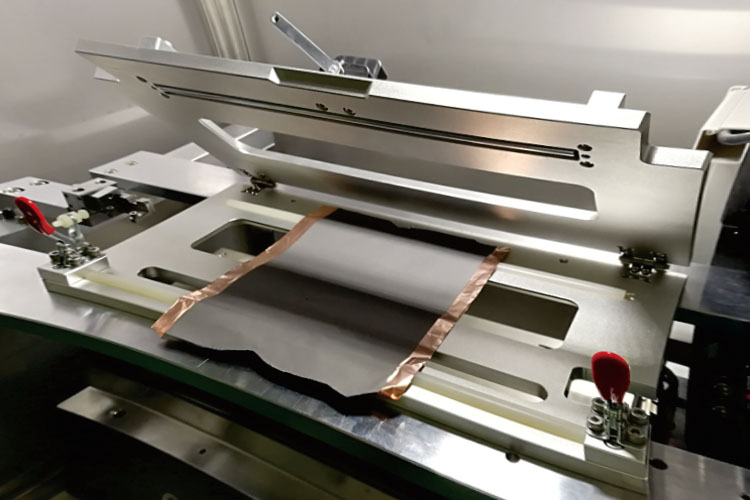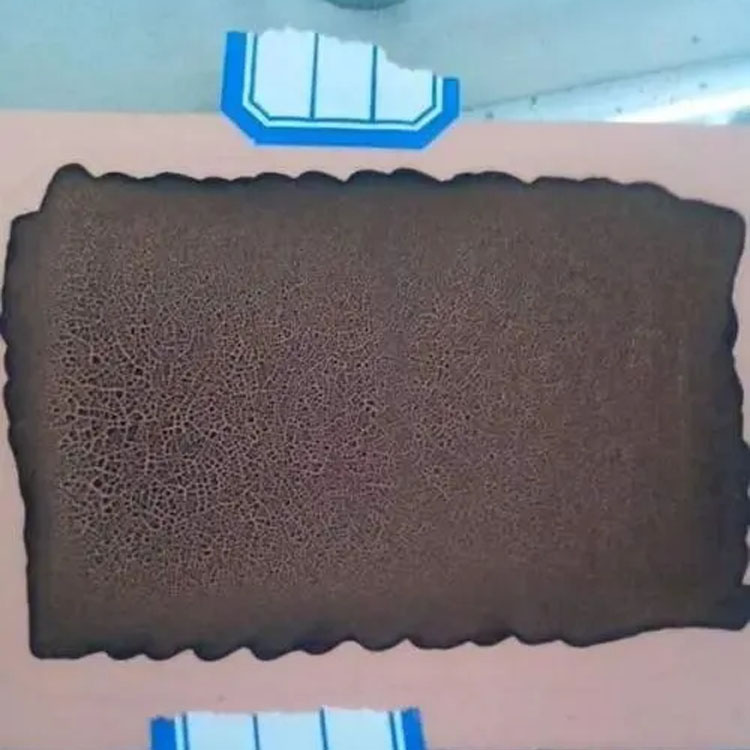Abstract: In the industrial processing of lithium-ion batteries, die extrusion coating has become the most widely used coating method because of its advantages of high precision, wide coating window and high reliability. Slurry is supplied by a precise feed system (e.g., a screw pump) into the inner cavity of the die head, evenly distributed across the width of the coating, and finally extruded through the die head slit to form a coating on the moving substrate. Due to the slurry fluid characteristics, it is easy to form a half-moon shape as shown in Figure 1 at the starting point, the ending point and the edges on both sides of the coating. In the coating process, the appearance of this sudden thickness increase at the edge of the pole plate is called the "thick edge" phenomenon.
The coating principle is explained
Coating refers to the method of coating paste polymer, molten polymer or polymer melt on paper, cloth, plastic film to make composite materials (films).
As the name suggests, the coating machine is a kind of mechanical equipment that will roll the substrate such as paper, cloth, leather, aluminum foil, plastic film, etc., coated with a layer of glue, paint or ink with a specific function, and then rolled after drying. It exists in all aspects of national industrial manufacturing, here refers to the power lithium battery raw materials coated on the battery conductive substrate above a device, through this coating method to produce lithium battery positive and negative electrode sheet.
From the point of view of process flow, coating is the key process in the process of cell preparation, from the point of view of equipment value is the key process in the process of cell preparation (high-end series price of more than 10 million), from the point of view of nonlinear control is the key process in the process of cell preparation; Coating uniformity, consistency, alignment, baking stability, binder diffusivity, surface density stability are closely related to this. The quality of the coating is directly related to the quality of the battery, while the lithium-ion battery due to the characteristics of the system makes it very sensitive to water, trace water may have a serious impact on the electrical performance of the battery (high nickel, such as 811/905 series is more obvious); Coating performance is directly related to the cost, pass rate and other practical indicators.
First, introduction
During the rolling process, the thick edge of the electrode is subjected to greater pressure, which not only causes the transverse density of the electrode to be different, but also causes the living matter particles at the thick edge to be crushed. After pressing, the electrode with thick edge defects will appear serious warping phenomenon, which will also have great influence on the subsequent slabbing and winding process. After the live matter particles at the thick edge are crushed, the transmission path of lithium ions and electrons becomes far away during the charging and discharging process, which will cause the internal resistance of the battery to increase and the polarization to deepen, which will affect the service life and safety of the battery. Therefore, it is of great practical significance to deeply study the cause, influence and solution of "thick edge" phenomenon.


Second, the performance and characteristics of the "thick edge" phenomenon
(1) The thick edge of the coating starting point and the end point In the coating starting stage, the slurry has not yet formed a stable flow state, and it is easy to accumulate at the starting point, resulting in a sudden increase in coating thickness. At the end of coating, the supply of slurry suddenly stops, but the flow inertia will make the slurry continue to accumulate at the end point, thus forming a thick edge.
(2) The thick edge of both sides of the edge in the coating process, because the shear force of the slurry at the edge is different from the inside, it is easy to have uneven flow, resulting in an increase in the thickness of the edge of the coating on both sides, forming a half-moon shape.
This phenomenon of thick edge will not only lead to the uneven thickness of the coating, but also affect the electrochemical performance and safety of the battery.
Third, the cause of the "thick edge" phenomenon
(1) Slurry fluid characteristics
1. The viscosity and surface tension of the slurry: when the viscosity of the slurry is high or the surface tension is large, its fluidity becomes poor, and it is easy to form accumulation during the coating process, resulting in the generation of thick edge phenomenon.
2. Thixotropy of the paste: Some pastes have thixotropy, that is, the viscosity decreases under shear force and the viscosity recovers at rest. This property can lead to changes in the viscosity of the paste at the starting and ending points during the coating process, resulting in thick edges.
(2) The coating process parameters exceed the coating window range
1. Slurry flow rate: excessive slurry flow rate will make the amount of slurry coated per unit time too much, at the starting point, end point and edge can not be evenly distributed in time, resulting in thick edges.
2. Coating speed: Too fast coating speed may cause the slurry to be spread evenly on the surface of the coating, especially in the edge area, which is easy to form a thick edge.
3. Slit gap: The slit gap is set unreasonable, such as the gap is too large or too small, will affect the flow uniformity of the slurry, resulting in thick edge problems.
(3) Improper temperature control during baking
1.Baking temperature is too high: too high baking temperature will make the binder in the coating quickly volatilization or migration, resulting in a change in the fluidity of the slurry at the edge, resulting in the formation of a thick edge.
2. Uneven temperature distribution: In the baking process, if the temperature distribution is uneven, it will lead to different drying rates of the coating in different areas, and it may also cause thick edge phenomenon.
Fourth, the impact of the "thick edge" phenomenon on the battery process and performance
(A) The impact on the battery process
1. It increases the difficulty of subsequent processes: uneven coating thickness will make subsequent rolling, cutting and other processes difficult to control, affecting production efficiency and product quality.
2. Affect the consistency of the electrode: the thick edge phenomenon will lead to a large difference in the thickness of the same batch of electrodes, reducing the consistency of the electrode, thus affecting the overall performance of the battery.
(2) Impact on battery performance
1. Impact on energy density: Energy density refers to the ability of the battery to store electricity per unit volume, which is a key parameter to measure the performance of the battery. The energy density of lithium-ion batteries is closely related to the thickness of the electrode plate. The thinner the thickness of the electrode, the smaller the amount of electricity stored by the battery; On the contrary, the thicker the electrode, the greater the storage capacity of the battery. However, because the volume of the active substance of the battery is constant, the thickness of the electrode increases, its specific surface area decreases, the electron transport path between the particles increases, and the resistance increases, resulting in the opposite effect. Therefore, to find a balance between energy density, cycle life and safety, select an appropriate electrode thickness.
2. Impact on cycle life: cycle life is the number of times that the battery can cycle charge and discharge, which is an important indicator to evaluate the battery performance. The thickness of the electrode also has a certain influence on the cycle life of the battery. In the process of charge and discharge, lithium ions will be embedded and deembedded on the surface of the electrode plate. This process involves lithium ion diffusion and electron conduction on the electrode surface. If the pole plate is too thick, the distance of lithium ion transmission increases, and the stress and deformation caused by the diffusion reaction increase, which is easy to lead to the spalling, cracking and damage of the pole plate, thus affecting the cycle life.
3. Impact on safety: The safety of lithium-ion batteries is directly related to whether the batteries will cause safety accidents such as combustion and explosion in use. The size of the electrode thickness also has an impact on the safety of the battery. On the one hand, the pole plate is too thick, and the heat transfer inside the battery is poor, which easily leads to local overheating during use; On the other hand, the pole is too thin, easy to occur internal short circuit, making the battery temperature rise, more likely to cause safety accidents.
Fifth, the solution to the "thick edge" phenomenon
(1) Optimize the coating process parameters
1. Precise control of slurry flow: By optimizing the feeding system, the use of high-precision metering pump and flow controller to ensure the stability and accuracy of slurry flow, so that it matches the coating speed and slit clearance.
2. Adjust the coating speed: according to the characteristics of the slurry and the ability of the equipment, choose the appropriate coating speed. Generally speaking, a slower coating speed contributes to the uniform spread of the paste, but at the same time, the requirements of production efficiency should also be considered.
3. Optimize the slit gap: Through experiments and simulations, determine the best slit gap to ensure that the slurry can flow evenly from the slit to form a uniform thickness of the coating.
(2) Improve slurry preparation
1. Optimize the slurry formulation: select the appropriate ratio of binder, conductive agent and active substance to improve the fluidity and stability of the slurry.
2. Improve the dispersion uniformity of the slurry: The use of advanced dispersion equipment and processes, such as high-speed stirring, ultrasonic dispersion, etc., to ensure that the particles in the slurry are evenly dispersed and avoid the occurrence of agglomeration.
3. Remove bubbles: In the slurry preparation process, take effective defoaming measures, such as vacuum defoaming, etc., to reduce the impact of bubbles in the coating process.
(3) Control the baking process
1. Optimize the baking temperature curve: according to the composition of the paste and the thickness of the coating, develop a reasonable baking temperature curve to avoid too high or too low temperature, and the temperature changes too fast.
2. Ensure uniform temperature distribution: Improve the structure and heating method of baking equipment, such as using hot air circulation or infrared heating, etc., to ensure the uniformity of temperature distribution of the coating during baking.
Sixth, conclusion
The "thick edge" phenomenon in the negative electrode coating process of lithium battery is a complicated problem, which involves many aspects such as slurry fluid characteristics, coating process parameters and baking process. Through in-depth analysis of its causes and effects, and taking effective solutions, such as optimizing the coating process parameters, improving the slurry preparation and controlling the baking process, the occurrence of thick edge phenomenon can be significantly reduced, and the performance and consistency of the battery can be improved.
Contact: Jason Wang
Phone: 13580725992
E-mail: sales@aooser.com
Whatsapp:13580725992
Add: No.429 Guangming Road, Shenzhen City, Guangdong Province
We chat
